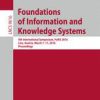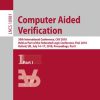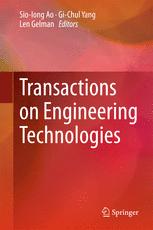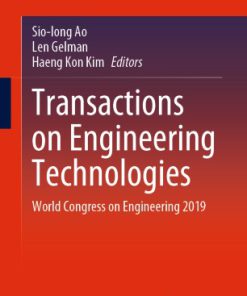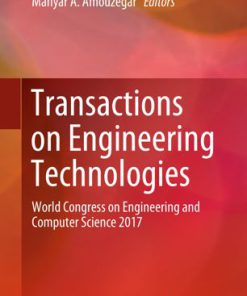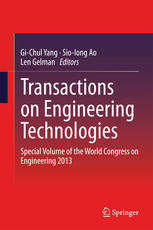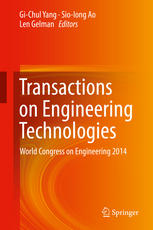Transactions on Engineering Technologies World Congress on Engineering and Computer Science 2015 1st edition by Mahyar Amouzegar, Sio Iong Ao, Haeng Kon Kim 9811027178 9789811027178
$50.00 Original price was: $50.00.$25.00Current price is: $25.00.
Transactions on Engineering Technologies World Congress on Engineering and Computer Science 2015 1st edition by Mahyar A. Amouzegar, Sio-Iong Ao, Haeng Kon Kim – Ebook PDF Instant Download/DeliveryISBN: 9811027178, 9789811027178
Full download Transactions on Engineering Technologies World Congress on Engineering and Computer Science 2015 1st edition after payment.
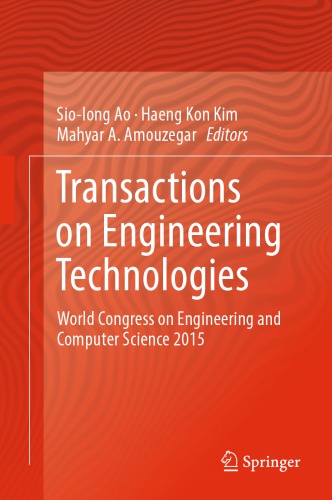
Product details:
ISBN-10 : 9811027178
ISBN-13 : 9789811027178
Author: Mahyar A. Amouzegar, Sio-Iong Ao, Haeng Kon Kim
This proceedings volume contains selected revised and extended research articles written by researchers who participated in the World Congress on Engineering and Computer Science 2015, held in San Francisco, USA, 21-23 October 2015. Topics covered include engineering mathematics, electrical engineering, circuits, communications systems, computer science, chemical engineering, systems engineering, manufacturing engineering, and industrial applications. The book offers the reader an overview of the state of the art in engineering technologies, computer science, systems engineering and applications, and will serve as an excellent reference work for researchers and graduate students working in these fields.
Transactions on Engineering Technologies World Congress on Engineering and Computer Science 2015 1st table of contents:
1 Estimate the Impact of Different Heat Capacity Approximation Methods on the Numerical Results Dur
1.1 Introduction
1.2 Description of the Entalphy Formulation
1.2.1 The Enthalpy and the Effective Heat Capacity
1.2.2 The Types of the Entalphy Formulations
1.3 Approximation of the Effective Heat Capacity
1.4 Numerical Model of Solidification
1.5 Used Software of Engineering Simulation
1.6 Results of the Numerical Experiment
1.7 Conclusions
References
2 Analysis of Systemic Risk: A Dynamic Vine Copula-Based ARMA-EGARCH Model
2.1 Introduction
2.2 Methodology
2.2.1 Risk Methodology
2.2.2 Univariate ARMA-EGARCH Model
2.2.3 Sklar’s Theory
2.2.4 Parametric Copulas
2.2.5 Vine Copulas
2.2.6 Tail Dependence
2.2.7 Estimation Method
2.3 Data and Empirical Findings
2.3.1 Data Representation
2.3.2 Results for the Marginal Models
2.3.3 Results for the Copula Models
2.3.4 Results for the Copula VaR and Copula VaR Ratio
2.4 Conclusion
References
3 MOESP_AOKI_VAR: Algorithm for Space State Identification of Non-stationary Multivariable Noisy Lin
3.1 Introduction
3.2 Foundation
3.2.1 Stationary Deterministic Linear System
3.2.2 Stationary Noisy Linear System
3.2.3 Non-stationary Deterministic Linear System
3.2.4 Non-stationary Noisy Linear System
3.2.5 Time Variant Identification
3.2.6 Deterministic-Stochastic Modelling of the State Space of Non-stationary System
3.3 MOESP_AOKI_VAR Algorithm
3.4 Experimentation and Results
3.5 Conclusions
References
4 Comparative the Performance of Control Charts Based on Copulas
4.1 Introduction
4.2 Research Methodology
4.2.1 Multivariate Exponentially Weighted Moving Average Control Chart
4.2.2 Double Multivariate Exponentially Weighted Moving Average Control Chart
4.2.3 Multivariate Cumulative Sum Control Chart
4.2.4 Copulas Concepts
4.2.4.1 Normal Copula
4.2.4.2 Archimedean Copulas
4.2.5 Dependence and Kendall’s tau
4.3 Numerical Results
4.4 Conclusion and Future Work
Acknowledgments
References
5 Mamdani Fuzzy Decision Model for GIS-Based Landslide Hazard Mapping
5.1 Introduction
5.2 Theoretical Framework
5.3 Methods
5.3.1 Study Area
5.3.2 Risk Indicators of Landslides
5.3.3 Fuzzy Decision Model for Landslide Hazard Assessment
5.3.3.1 Fuzzification of the Input Variables
5.3.3.2 Rule Evaluation
5.3.3.3 Aggregation of the Output Rules
5.3.3.4 Defuzzification
5.3.4 Geographic Information System for Landslide Hazard Mapping
5.4 Results and Discussion
5.5 Conclusion
5.6 Recommendation
Acknowledgements
References
6 Laser Scanning as a Tool for the Analysis of Historical Buildings
6.1 Introduction
6.2 2D Documentation
6.3 Types of 3D Scanners
6.4 Possibilities of Using Data Obtained from Measurements Using Laser Scanners
6.5 Application of 3D Laser Scanners to Determine the Geometry of Historical Buildings
6.6 3D Modeling in Analysis of Historical Buildings
6.7 The Procedures Needed to Obtain a Digital Model of Analyzed Structures
6.8 Evaluation of the Accuracy of Created 3D Models
6.9 Software
6.10 Fem Analysis of Historical Building
6.11 Conclusions
References
7 A Simulation Study on Performance Validation of Indoor Location Estimation Based on the Radial Pos
7.1 Introduction
7.2 Time of Arrival (ToA) Data
7.3 Indoor Location Estimation Algorithm
7.3.1 Radial Weibull Distribution
7.3.2 Radial Log-Normal Distribution
7.3.3 Location Estimation Based on the Radial Distribution
7.4 Simulation Study
7.4.1 Simulation Results
7.5 Conclusions
References
8 Semi-supervised Classification with Modified Kernel Partial Least Squares
8.1 Introduction
8.2 Methodology
8.2.1 Partial Least Squares
8.2.2 Classification Using PLS Method
8.2.3 Gaussian Mixture Model
8.2.4 Support Vector Machine (SVM)
8.2.5 Proposed Semi-supervised Modified PLS Method
8.3 Experiments
8.4 Conclusions
References
9 2D-DOAE Improvement Using ESPRIT with Doppler Correction
9.1 Introduction
9.2 T-ESPRIT Method for 2D Case
9.3 Spatial Subspace Method
9.4 Doppler Correction for TS-ESPRIT Method
9.4.1 DOAE Using the Modified TS-ESPRIT Method
9.5 Simulation Results and Analyses
9.5.1 Spatial Subspace Method Application
9.6 Conclusions
References
10 Pathologies Segmentation in Eye Fundus Images Based on Frequency Domain Filters
10.1 Introduction
10.2 Mathematical Background
10.2.1 Frequency Transforms
10.2.2 Spatial Frequency Filters
10.3 Illumination Correction and Edge Detection
10.4 Segmentation of Eye Fundus Pathologies
10.5 Pathologies Segmentation Results
10.6 Conclusion
References
11 The Distribution of HIV/AIDS Commodities: NPOS and Sustainability
11.1 Introduction
11.2 Literature Review
11.3 Methodology
11.4 Results
11.4.1 Distribution
11.4.2 Storage
11.5 Recommendation
11.5.1 Non-governmental Organisations (NGOs)
11.5.1.1 Governance
11.5.1.2 Lack of Governance Structures
11.5.1.3 Efficacy of Boards
11.5.1.4 Benefits of Merging
11.6 Conclusion
References
12 Representation of a DNA Sequence by a Substring of Its Genetic Information
12.1 Introduction
12.2 State of the Art
12.3 New Approaches to DNA Sequences Alignment
12.3.1 Motivations
12.3.2 Algorithm for Determining a Best Local Optimal Alignment
12.3.2.1 Introducing the Approach
12.3.2.2 Algorithm
12.3.2.3 Complexity of the Approach
12.4 Experimental Results
12.4.1 Species of the Experiments
12.4.1.1 Experimental Results for Species of the Same Genus
12.4.1.2 Experimental Results for a Set of Species of the Phylum Firmicutes
12.4.1.3 Experimental Results for Random Species
12.4.2 Results in Term of Percentages of Similarity
12.4.2.1 Sequences from the Same Genus
12.4.2.2 Sequences from the Same Phylum
12.4.2.3 Sequences from Random Species
12.4.3 Experiments in Terms of Execution Time
12.5 Conclusion and Future Work
Acknowledgements
References
13 Fatal Flaws in Norwich’s “Mystery of Loudness Adaptation”
13.1 Introduction
13.2 Two “Loudness Laws” into One
13.2.1 The “Entropy Equation” for Loudness Growth
13.2.2 Does Loudness Actually Follow the Entropy Equation?
13.3 The Units of Tone Magnitude
13.3.1 “Decibels Sensation Level”
13.3.2 Loudness-Equation Parameters
13.4 Algebra for Loudness-Matching
13.5 Algebra for Loudness Adaptation
13.5.1 Loudness: Its Alleged Time-Dependence
13.5.2 Loudness as a Logarithmic Equation: The Heart of Norwich’s Argument
13.5.3 Adaptation to a Fixed-Intensity Auditory Stimulus
13.6 Why no Monaural Adaptation?
13.7 Summary: Norwich’s “Mystery of Loudness Adaptation”
13.8 Discussion: Norwich’s Use of Units
13.9 Conclusions
Acknowledgements
References
14 Wrong Limits and Wrong Assumptions: Kenny Norwich and Willy Wong Fail to Derive Equal-Loudness Co
14.1 Introduction
14.2 Norwich and Wong: A Loudness Equation
14.3 Norwich and Wong: The “Weber Fraction”
14.4 Norwich and Wong: Derivation of Equal-Loudness Contours
14.5 Examining Norwich and Wong (1): The Loudness Equation at the Loudness Threshold
14.6 Examining Norwich and Wong (2): The Constancy of K
14.7 Examining Norwich and Wong (3): Entropy Exponent, Stevens Exponent
14.8 Examining Norwich and Wong (4): Frequency-Dependence of the Exponent
14.9 Conclusions
Acknowledgement
References
15 High Assurance Asynchronous Messaging Methods
15.1 Introduction
15.1.1 Some Advantages of Asynchronous Communication
15.1.2 Some Disadvantages of Asynchronous Communication
15.2 High Assurance Issues
15.3 Prior Work
15.3.1 Java Standard Messaging Protocol
15.3.2 De-Facto Standard Microsoft Message Queuing
15.3.3 Open Source Messaging Protocols
15.3.4 Emerging Standard Advanced Message Queuing Protocol
15.4 Asynchronous Messaging Security
15.4.1 Security for Server Brokered Invocation
15.4.2 Security for Publish Subscribe Systems
15.5 Pss Rock and Jewel
15.5.1 Claims for Targeted Content (PSS)
15.5.2 Retrieving Content for Known Claimants
15.5.3 Retrieving Content for Unknown Claimants
15.5.4 Adjusting Publishing Targets (Untrusted PSS)
15.5.5 Distribution of Burdens
15.6 Summary
References
16 Regional Differences in Iwate Prefecture Road Usage Recovery Following the 2011 Tohoku Earthquake
16.1 Introduction
16.1.1 The 2011 Tohoku Earthquake
16.1.2 Purpose of the Study
16.2 Our Previous Studies
16.2.1 Previous Study 1
16.2.2 Previous Study 2
16.2.3 Previous Study 3
16.3 Telematics Data and Vehicle-Tracking Map
16.4 Research Methods
16.4.1 Research Area
16.4.2 Research Materials
16.4.3 System
16.4.4 Data Processing
16.5 Results
16.5.1 Regional Road Usage Recovery Differences
16.5.2 Cities Whose Road Recovery Was Extremely Delayed
16.6 Discussion
References
17 Computational Complexity Study of RSA and Elgamal Algorithms
17.1 Introduction
17.1.1 Classification of Computational Problems
17.2 Research Motivation
17.3 Research Methodology
17.4 RSA and Elgamal Algorithms
17.4.1 Elgamal Algorithm
17.4.2 RSA Algorithm
17.5 Results
17.6 Analysis of Results
17.7 Conclusion and Future Research
Acknowledgement
References
18 Ontology-Based Context Modeling and Reasoning for a Smart Space
18.1 Introduction
18.2 Related Work
18.3 The Smart Living Room
18.3.1 Description
18.3.2 Sample Operation Scenario
18.4 Ontology-Based Modeling
18.4.1 Smart Living Room Modeling
18.4.2 Context Modeling
18.5 Context Reasoning
18.6 Conclusion and Future Work
References
19 Performance Analysis of Heed Over Leach and Pegasis in Wireless Sensor Networks
19.1 Introduction
19.2 Problem Formulation
19.3 Metric Considered
19.4 Methodology
19.5 Simulation Results
19.6 Conclusion
References
20 Spectral Properties and Error Rate Performance of Digital Chirp Communication System
20.1 Introduction
20.2 M-ary Chirp System Model
20.2.1 M-ary Chirp Signalling Technique
20.2.2 Optimum Correlator-Receiver
20.2.3 Symbol Error Rate Performance
20.3 Performance of Optimum Receiver over Fading Channels
20.3.1 Rayleigh Fading Channel
20.3.2 Nakagami-m Fading Channel
20.3.3 Generalized-K Fading and Shadowing Channel
20.4 Spectra of the M-ary Chirp Signals
20.5 Conclusion
References
21 Power Factor Control Mechanism for Optimum Efficiency in Wind Generators and Industrial Applicati
21.1 Introduction
21.2 Modeling Techniques of the BDFRG
21.3 Controller System Mechanism
21.4 Voltage Control (Vc)
21.5 OPFC Mechanism of BDFRG Wind Generator
21.6 Simulation Results
21.7 Experiment and Results
21.8 Conclusion and Future Work
References
22 TBSC Compensator
22.1 Introduction
22.2 Objectives
22.3 Theme
22.4 Proposed Work
22.5 Simulation Results
22.6 Hardware Results
22.7 Conclusion and Future Work
Acknowledgements
References
23 Sensorless Speed Estimation by Using Rotor Slot Harmonics for Squirrel Cage Induction Motor
23.1 Introduction
23.2 Speed Calculation Method Using Square Wave Speed Sensor
23.3 Sensorless Speed Estimation Method
23.4 Experimental Study and Results
23.5 Conclusion and Future Work
Acknowledgement
References
24 Selective Harmonic Elimination Technique Based on Genetic Algorithm for Multilevel Inverters
24.1 Introduction
24.2 Proposed Multilevel Inverter with Reduced Number of Switches
24.3 Calculation of Switching Angles Using Shepwm Technique
24.4 Genetic Algorithm Based She Technique
24.5 Simulation Results
24.6 Conclusion
References
25 Proposal of a Modulated Extended Cumulative Exposure Model for the Step-Up Voltage Test
25.1 Introduction
25.2 Step-Stress Test
25.3 Proposed Modulated Extended Cumulative Exposure Model Based on Time-Scale Changing
25.3.1 Cumulative Exposure Model, CEM
25.3.2 Memoryless Model (MM)
25.3.3 Extended Cumulative Exposure Model (ECEM)
25.3.4 Modulated Extended Cumulative Exposure Model
25.4 Simulation Study
25.5 Experimental Case
25.6 Discussion
25.7 Conclusion
References
26 Gesture Recognition Sensor: Development of a Tool with Playful Applications to Evaluate the Phys
26.1 Introduction
26.2 Influence Area
26.2.1 Factors that Influence the Evolutionary Development of the Child
26.2.2 Attention Deficit in Ecuadorian Children
26.2.3 The Education with Games
26.3 Evaluation Techniques
26.3.1 Bootstrap Algorithm
26.3.2 Methodology Using Gesture Recognition Sensor
26.3.3 Detection of Skeleton
26.3.4 Position of Points of Interest
26.3.5 Gesture Recognition
26.3.6 Remote Communications Network to Store in the Database
26.4 Applications Running
26.4.1 Learning the Colors
26.4.2 Learning the Numbers
26.4.3 Learning the Figures
26.4.4 Learning Animals
26.4.5 Avatar
26.5 Results Analysis Through the Use of the Algorithm Bootstrap
26.5.1 Learning the Colors
26.5.2 Learning the Numbers
26.5.3 Learning the Figures
26.6 Conclusions
References
27 Design of Learning Ontology and Service Model Through Achievement Standards Profile Modeling
27.1 Introduction
27.2 Related Work
27.3 Comparison Between ASN Framework and Korean Achievement Standards
27.4 Achievement Standards Profile Modeling
27.4.1 Class Definition
27.4.2 Property Definition
27.4.3 Adaptive Learning Service Modeling
27.4.4 Linked Open Data Specification
27.5 Conclusion and Future Work
References
28 Web Retrieval with Query Expansion: A Parallel Retrieving Technique
28.1 Introduction
28.2 Island Genetic Algorithms (IGAs)
28.3 Methodology
28.3.1 Preprocessing Phase
28.3.2 Inverted Index Generator Phase
28.3.3 Document Retrieving Phase
28.3.3.1 Genetic Search Stage
28.3.3.2 Query Expansion Stage
28.3.3.3 Decision Making Stage (Filtering)
28.4 Assessment of Experimental Results
28.5 Conclusion and Future Work
References
29 Enhanced Action Based Trust Model: A Multi-facet Model for Social Media
29.1 Introduction
29.2 State-of-Art on Trust Management in OSN
29.2.1 Trust Management in Current OSNs
29.2.2 Exisiting Trust Management Models
29.2.2.1 Online Reputation Models
29.2.2.2 Marsh Trust Management
29.2.2.3 Multi-context Trust Model
29.2.2.4 Trust Inference for Social Networks (TISoN)
29.2.2.5 Action-Based Trust Model
29.2.2.6 Multi-facet Trust Model with Ranked Trust Attributes
29.2.2.7 Context Aware Recommender Model
29.3 Multi-facet Trust Management Model with Ranked Design
29.4 Proposed of Enhanced Action-Based Trust (EABT) Model
29.5 Enhanced Action-Based Trust (EABT) Model (Miniosn 2.0)
29.6 Conclusion and Future Work
References
30 A Motorized Akpu Milling Machine Design for Self Employment and Wealth Generation in Nigeria
30.1 Introduction
30.1.1 Local Varieties
30.1.2 Evolution of Traditional Graters
30.1.3 Problem Statement
30.1.4 Objectives
30.1.5 Scope of Research
30.2 Economic Importance of Akpu Milling Machine
30.2.1 Handling and Processing
30.2.2 Processing
30.2.3 Industrial Uses Cassava Leaves and Livestock Feeds
30.2.4 Role of Akpu (Cassava) Products
30.3 Design of Akpu (Cassava) Milling Machine
30.3.1 Parts Design and Material Selection
30.3.2 Theoretical Design and Methodology
30.4 Design Analysis of the Transmission Drives
30.4.1 Determination of Rotor Diameter
30.4.2 Diameter of Motor Pulley
30.4.3 Value of Electric Motor
30.4.4 Value of Belt Based on the Power
30.4.5 Calculation of Belt Length, L
30.4.6 Design for Shaft
30.4.7 Determination of T1 and T2
30.4.8 Determination of Belt Cross Sectional Area
30.4.9 Value of Powertransmitted by the Belt
30.4.10 Number of Belt Used
30.5 Result and Discussion
30.5.1 Performance Evaluation
30.5.2 Rate of Cassava Grating
30.5.3 Constraints to Further Development of Akpu (Cassava) Production
30.6 Conclusion
Acknowledgements
References
31 Response Behavior Model for Process Deviations in Cyber-Physical Production Systems
31.1 Introduction
31.2 State of the Art
31.2.1 Cyber-Physical Production Systems
31.2.2 Modeling and Simulation of Cyber-Physical Production Systems
31.3 Process Deviations in Cyber-Physical Production Systems
31.3.1 Process Deviations, Failures, and Disturbances
31.3.2 Identifying and Categorizing Process Deviations
31.4 Modeling and Simulation
31.4.1 Modeling Response Behavior
31.4.2 Implementation
31.4.3 Results and Discussion
31.5 Conclusion
References
32 Complete Bid Configuration. Supporting the Process from the Perspective of the General Contract
32.1 Introduction
32.2 Objectives
32.3 Users
32.4 Constraints and Assumptions
32.5 Functional Requirements
32.6 Non-functional Requirements
32.6.1 Ergonomic Requirements
32.6.2 Performance Requirements
32.6.3 Requirements for the Working Environment
32.6.4 Safety Requirements
32.6.5 Legal Requirements
32.7 The Process of Contract Aquisition
32.8 Conclusion
References
33 HIV/AIDS Humanitarian Supply Chain Management: The Case of Zimbabwe
33.1 Introduction
33.2 Existing Literature Relevant to the Study
33.3 Methodology and Research Design
33.4 Results and Discussion
33.5 Conclusions and Recommendations
References
34 Techno-Econometric Analysis of Membrane Technology for Biogas Upgrading
34.1 Introduction
34.1.1 Membrane Technology for Biogas Upgrading
34.1.2 Economics of Biogas Upgrading
34.1.3 Conversion of Vehicles
34.1.4 Life Cycle Analysis
34.1.5 Research Objective
34.2 Methodology
34.2.1 Process Simulation and Data Collection
34.2.2 Process Economics
34.2.3 Cost Analysis of Biomethane as Vehicular Fuel
34.3 Result and Discussion
34.3.1 Simulation Validation
34.3.2 Methane Recovery and Product Purity
34.3.2.1 Effect of %CO2 in Feed
34.3.2.2 Effect of Feed Pressure
34.3.2.3 Effect of Membrane Selectivity
34.3.2.4 Feed Flow Rate
34.3.3 Compressor Power Requirement
34.3.4 Effect of Process Conditions on GPC
34.3.4.1 Effect of Feed Composition
34.3.4.2 Effect of Feed Pressure
34.3.4.3 Effect of Feed Flow Rate
34.3.5 Cost of Upgrading
34.3.6 Profitability of Upgrading and Utilization
34.4 Conclusion
Acknowledgements
References
35 Validation of a Novel Method for Ethyl Lactate Separation Using Langmuir Hinshelwood Model
35.1 Introduction
35.2 Experimental
35.2.1 Materials
35.2.2 Catalyst Cleaning
35.2.3 Batch Process Esterification
35.2.4 GC-MS
35.2.5 Catalyst Characterization
35.3 Results and Discussion
35.3.1 GC-MS Results
35.3.2 SEM Surface Morphology of Resin Catalysts
35.3.3 FTIR of Esterification Products
35.3.4 Model Validation and Parameters Estimation
35.4 Conclusion
Acknowledgements
References
36 Potential Impacts of Leachate From Waste Mixed With CCA-Treated Wood Destined to Landfills
36.1 Introduction
36.2 Practical Exploration
36.3 Results and Discussion
36.4 Conclusion and Future Work
Acknowledgements
References
37 The Use of Mathematical Modeling for the Development of a Low Cost Fuzzy Gain Schedule Neutraliza
37.1 Introduction
37.2 Theoretical Framework
37.3 Materials and Methods
37.3.1 Experimental System
37.3.2 Open Loop Tests
37.3.3 FOPDT Model Development
37.3.4 Fuzzy Controller Membership Functions Project
37.3.5 Fuzzy Controller Rules Definition
37.3.6 Fuzzy Gain Schedule Controller Implementation and Application
37.4 Conclusion
Acknowledgements
References
38 Recovery of VOC from Offshore and Onshore Shuttle Tankers Using Structured Y-Type Zeolite Membran
38.1 Introduction
38.1.1 VOCs Emission Sources
38.1.2 Factors affecting the Rate of VOC Emission from Onshore and Offshore Facilities
38.1.3 Loading Time
38.1.4 Effects of Ship Movement
38.1.5 Nature of Hydrocarbon
38.1.6 Temperature of Crude Oil
38.1.7 Absorption
38.1.8 Thermal Oxidation
38.1.9 Adsorption
38.1.10 Cryogenic Condensation
38.1.11 Reducing Volatility
38.1.12 Sequential Transfer
38.1.13 Membrane Separation
38.2 Experimental
38.2.1 Permeation Setup
38.2.2 Membrane Preparation
38.2.3 Membrane Characterization
38.3 Results and Discussion
38.4 Conclusion
Acknowledgment
References
39 Effect of Operating Pressure on Fischer-Tropsch Synthesis Kinetics over Titania-Supported Cobalt
39.1 Introduction
39.2 Experimental Procedure
39.2.1 Catalyst Preparation
39.2.2 Catalyst Evaluation
39.3 Results and Discussion
39.4 Conclusion
Acknowledgements
References
40 Characterization of Gamma-Alumina Ceramic Membrane
40.1 Introduction
40.2 Experimental
40.2.1 Materials
40.2.2 Characterization Techniques
40.2.2.1 Scanning Electron Microscope
40.2.2.2 Nitrogen Adsorption-Desorption
40.2.2.3 Gas Permeation Test
40.3 Results and Discussion
40.3.1 SEM Characterization
40.3.2 Nitrogen Adsorption-Desorption Characterization
40.3.3 Gas Permeation Analysis
40.4 Conclusion and Future Work
Acknowledgements
References
41 Investigation of Flue Gas and Natural Gas Separation Using Silica Composite Membranes Formed on P
41.1 Introduction
41.2 Experimental
41.3 Results and Discussion
41.4 Gas Permeation
41.5 Conclusion
People also search for Transactions on Engineering Technologies World Congress on Engineering and Computer Science 2015 1st:
technical branches in engineering
etc branch in engineering full form
transactions on engineering management
transactions on software engineering
engineering transactions
Tags: Transactions, Engineering Technologies, World Congress, Computer Science, Mahyar Amouzegar, Sio Iong Ao, Haeng Kon Kim
You may also like…
Engineering - Engineering Technology
Engineering - Engineering Technology
Engineering
Transactions on Engineering Technologies: World Congress on Engineering 2019 Sio-Iong Ao
Computers
Transactions on Engineering Technologies World Congress on Engineering 2014 1st Edition Gi-Chul Yang
Business & Economics - Management & Leadership Computers - Applications & Software
Engineering - Engineering Technology


